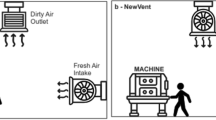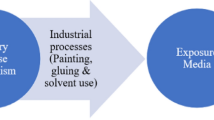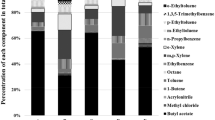Abstract
This article presents a review of the types and levels of volatile organic compounds (VOC) detected in a bra cup manufacturing facility (considering the past 4 years) while conducting a human health risk assessment to selected VOCs. Most of the tested VOCs were undetected, except in the flocking section in 2014. However, from time to time dichloromethane and toluene were detected in the facility. Dichloromethane levels showed an increase with time in the laminating section (except during 2014) with drastically higher levels in 2015. SWIFT VS1 6016/5A (an adhesive) as per the material safety data sheet (MSDS) was the dichloromethane source. However, none of the MSDS revealed the occurrence of carcinogenic benzene (which was detected in 2014 in the flocking section) and 1,4-dichlorobenzene (which was detected in 2013 in the laminating and injection molding sections) and non-carcinogenic toluene indicating that MSDS do not accurately provide the identity of chemicals. Hazard Indices (HI) for non-carcinogenic VOCs and the total lifetime cancer risks (LCRs) and occupational exposure indices (E i ) for carcinogenic VOCs varied during the different time periods. Toluene in many cases accounted for 100 % of the HI. LCRs and E i of dichloromethane accounted for 100 % of the total LCR and total E i , respectively (except in the flocking section in 2014). LCR and E i of the individual VOCs (even the total LCR and E i values) were simultaneously high whenever the levels of the individual VOCs had exceeded the regulatory limits posing a health risk. Some measures needed to prevent exposure to VOCs are discussed in this article.
Similar content being viewed by others
Notes
In the ZDHC Joint Roadmap, Version 2, ZDHC member brands such as NIKE, Puma and Levi Strauss & CO, etc committed to define and develop a Manufacturing Restricted Substances List (MRSL) for the apparel and footwear industry. The MRSL addresses hazardous substances potentially used and discharged into the environment during manufacturing and related processes, not just those substances that could be present in finished products.
References
Ahmadkhaniha R, Yunesian M, Jeddi MZ, Rastkari N (2016) Determination of urinary concentrations of organic solvent in urban workers. J Air Pollut Health 1:21–26
An T, Huang Y, Li G, He Z, Chen J, Zhang C (2014) Pollution profiles and health risk assessment of VOCs emitted during e-waste dismantling processes associated with different dismantling methods. Environ Int 73:186–194
Baek SO, Kim YS, Perry R- (1997) Indoor air quality in homes, offices and restaurants in Korean urban areas—indoor/outdoor relationships. Atmos Environ 31:529–544
Chang YM, Hu WH, Fang WB, Chen SS, Chang CT, Ching HW (2011) A Study on dynamic volatile organic compound emission characterization of water-based paints. J Air Waste Manag Assoc 61(1):35–45
Chen H, Teng Y, Lu S, Wang Y, Wang J (2015) Contamination features and health risk of soil heavy metals in China. Sci Total Environ 512–513:143–153
Guo H, Murray F, Wilkinson S (2000) Evaluation of total volatile organic compound emissions from adhesives based on chamber tests. J Air Waste Manag Assoc 50:199–206
Guo H, Lee SC, Chan LY, Li WM (2004) Risk assessment of exposure to volatile organic compounds in different indoor environments. Environ Res 94:57–66
He Z, Li G, Chen J, Huang Y, An T, Zhang C (2015) Pollution characteristics and health risk assessment of volatile organic compounds emitted from different plastic solid waste recycling workshops. Environ Int 77:85–94
Huang DY, Zhou SG, Hong W, Feng WF, Tao L (2013) Pollution characteristics of volatile organic compounds, polycyclic aromatic hydrocarbons and phthalate esters emitted from plastic wastes recycling granulation plants in Xingtan Town, South China. Atmos Environ 71:327–334
Jia C, Batterman S, Godwin C (2008) VOCs in industrial, urban and suburban neighborhoods, Part 1: indoor and outdoor concentrations, variation, and risk drivers. Atmos Environ 42:2083–2100
Khanchi A, Hebbern CA, Zhu J, Cakmak S (2015) Exposure to volatile organic compounds and associated health risks in Windsor, Canada. Atmos Environ 120:152–159
Kim YM, Harrad S, Harrison RM (2002) Levels and sources of personal inhalation exposure to volatile organic compounds. Environ Sci Technol 36:5405–5410
Lee SC, Li WM, Chan LY (2001) Indoor air quality at restaurants with different styles of cooking in metropolitan Hong Kong. Sci Total Environ 279:181–193
Lee SC, Guo H, Li WM, Chan LY (2002a) Inter-comparison of air pollutant concentrations in different indoor environments in Hong Kong. Atmos Environ 36:1929–1940
Lee SC, Li WM, Ao CH (2002b) Investigation of indoor air quality at residential homes in Hong Kong—case study. Atmos Environ 36:225–237
Lee CW, Dai YT, Chien CH, Hsu DJ (2006) Characteristics and health impacts of volatile organic compounds in photocopy centers. Environ Res 100:139–149
Li WM, Lee SC, Chan LY (2001) Indoor air quality at nine shopping malls in Hong Kong. Sci Total Environ 273:27–40
Li G, Zhang Z, Sun H, Chen J, An T, Li B (2013) Pollution profiles, health risk of VOCs and biohazards emitted from municipal solid waste transfer station and elimination by an integrated biological-photocatalytic flow system: a pilot-scale investigation. J Hazard Mater 250–251:147–154
Li L, Li H, Zhang X, Wang L, Xu L, Wang X, Yu Y, Zhang Y, Cao G (2014) Pollution characteristics and health risk assessment of benzene homologues in ambient air in the northeastern urban area of Beijing, China. J Environ Sci 26:214–223
Makino T, Matsumoto K, Ebara T, Mine T, Ohtsuka T, Mizuguchi J (2007) Complete decomposition of benzene, toluene, and particulate matter contained in the exhaust of diesel engines by means of thermally excited holes in titanium dioxide at high temperature. Jpn J Appl Phys 46:6037–6042
Masters GM (2000) Introduction to environmental engineering and science, 4th edn. Prentice-Hall, New Delhi
Neghab M, Hosseinzadeh K, Hassanzadeh J (2015) Early liver and kidney dysfunction associated with occupational exposure to sub-threshold limit value levels of benzene, toluene, and xylenes in unleaded petrol. Saf Health Work 6:312–316
Nielsen GD, Larsen ST, Olsen O, Løvik M, Poulsen LK, Glue C, Wolkoff P (2007) Do indoor chemicals promote development of airway allergy? Indoor Air 17:236–255
Ramírez N, Cuadras A, Rovira E, Borrull F, Marcé RM (2012) Chronic risk assessment of exposure to volatile organic compounds in the atmosphere near the largest Mediterranean industrial site. Environ Int 39:200–209
Weeratne B (2004) Textile and apparel industry in Sri Lanka: an empirical analysis in a globalization setting. 3rd East-west center international graduate student conference, Feb 19–21 2004 in Honolulu, Hawai
Wilke O, Jann O, Brödner D (2004) VOC- and SVOC-emissions from adhesives, floor coverings and complete floor structures. Indoor Air 14:98–107
Acknowledgments
The work reported in this article is a part of a dissertation submitted to the National Institute of Occupational Safety and Health (NIOSH), Sri Lanka to fulfil the requirements of the National Diploma in Occupational Safety and Health. I thank Mrs Blossom Lakshmi Kularatne (my mother) for encouraging me to follow this course. Professor Majid Abbaspour (Chief Editor of this journal) and the anonymous reviewers provided useful comments and suggestions to drastically improve this article.
Author information
Authors and Affiliations
Corresponding author
Additional information
Editorial responsibility: M. Abbaspour.
Rights and permissions
About this article
Cite this article
Kularatne, R.K.A. Occurrence of selected volatile organic compounds in a bra cup manufacturing facility. Int. J. Environ. Sci. Technol. 14, 315–322 (2017). https://doi.org/10.1007/s13762-016-1145-6
Received:
Revised:
Accepted:
Published:
Issue Date:
DOI: https://doi.org/10.1007/s13762-016-1145-6




